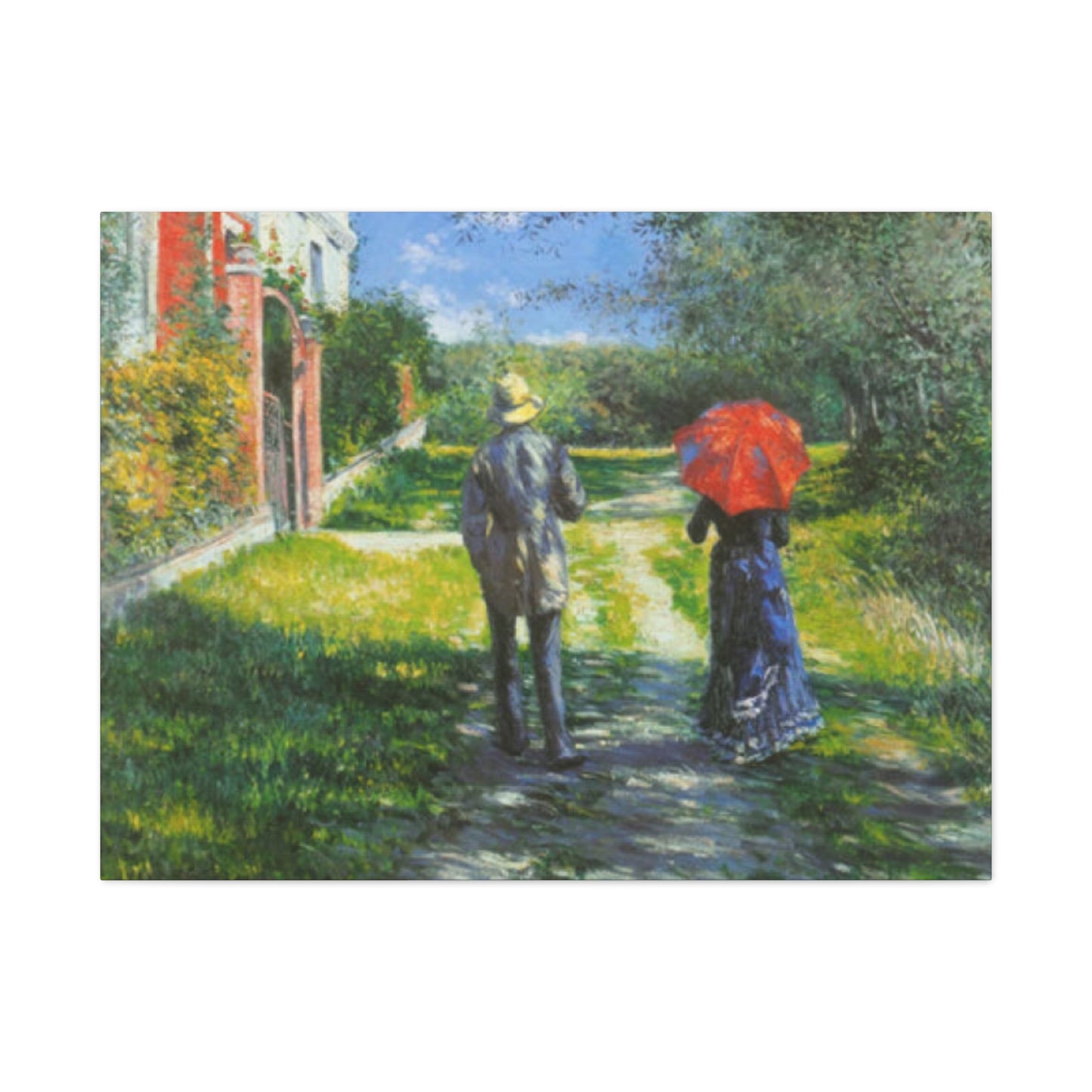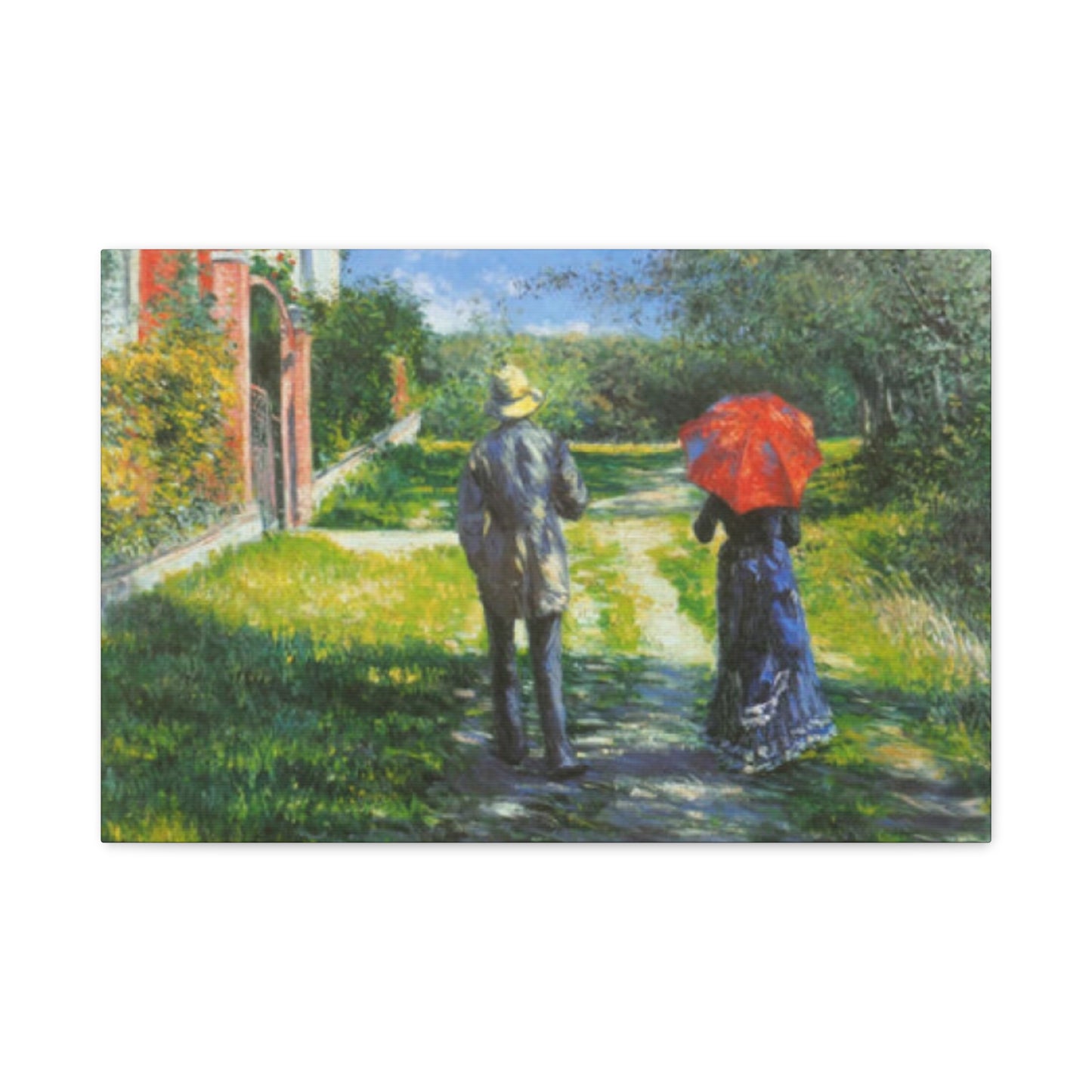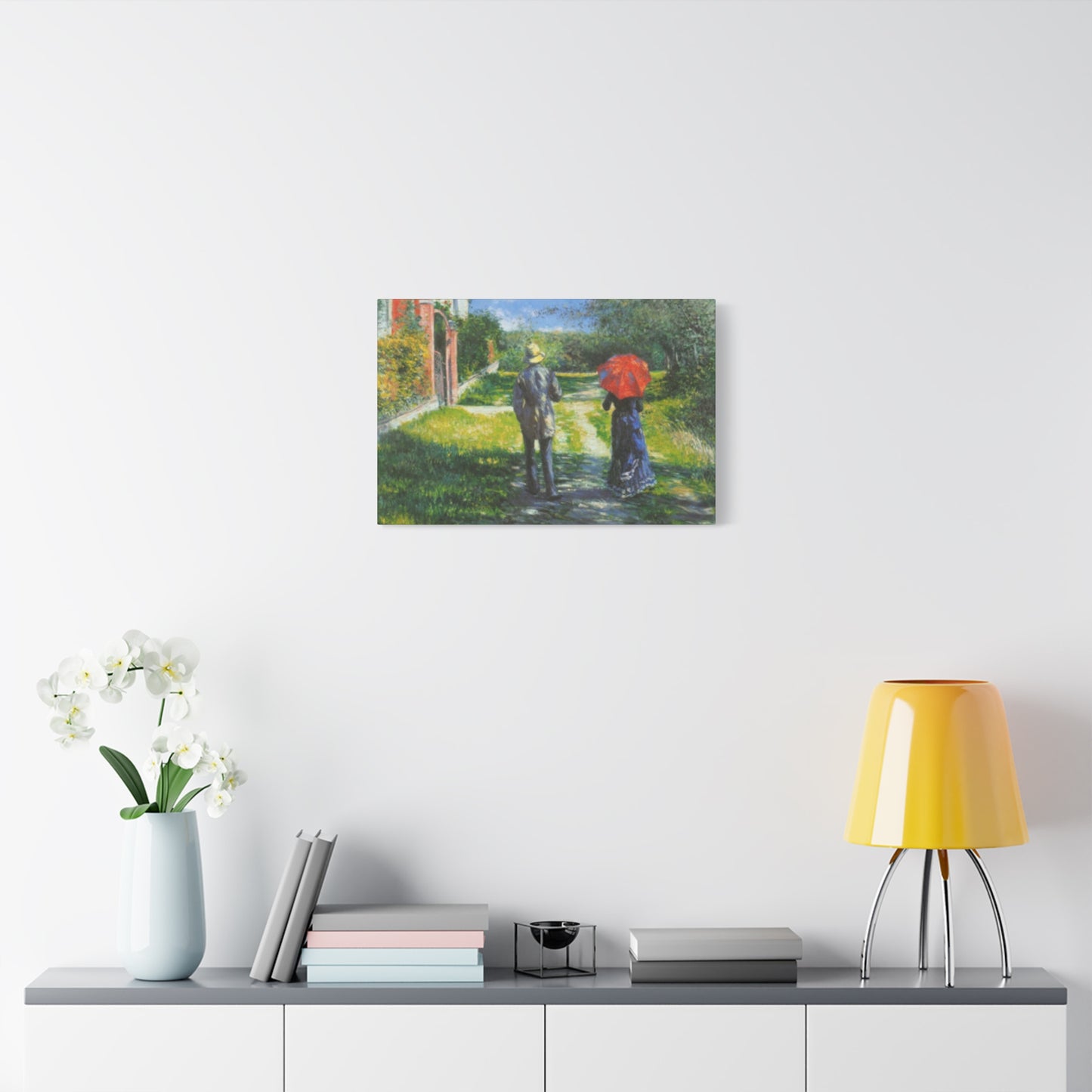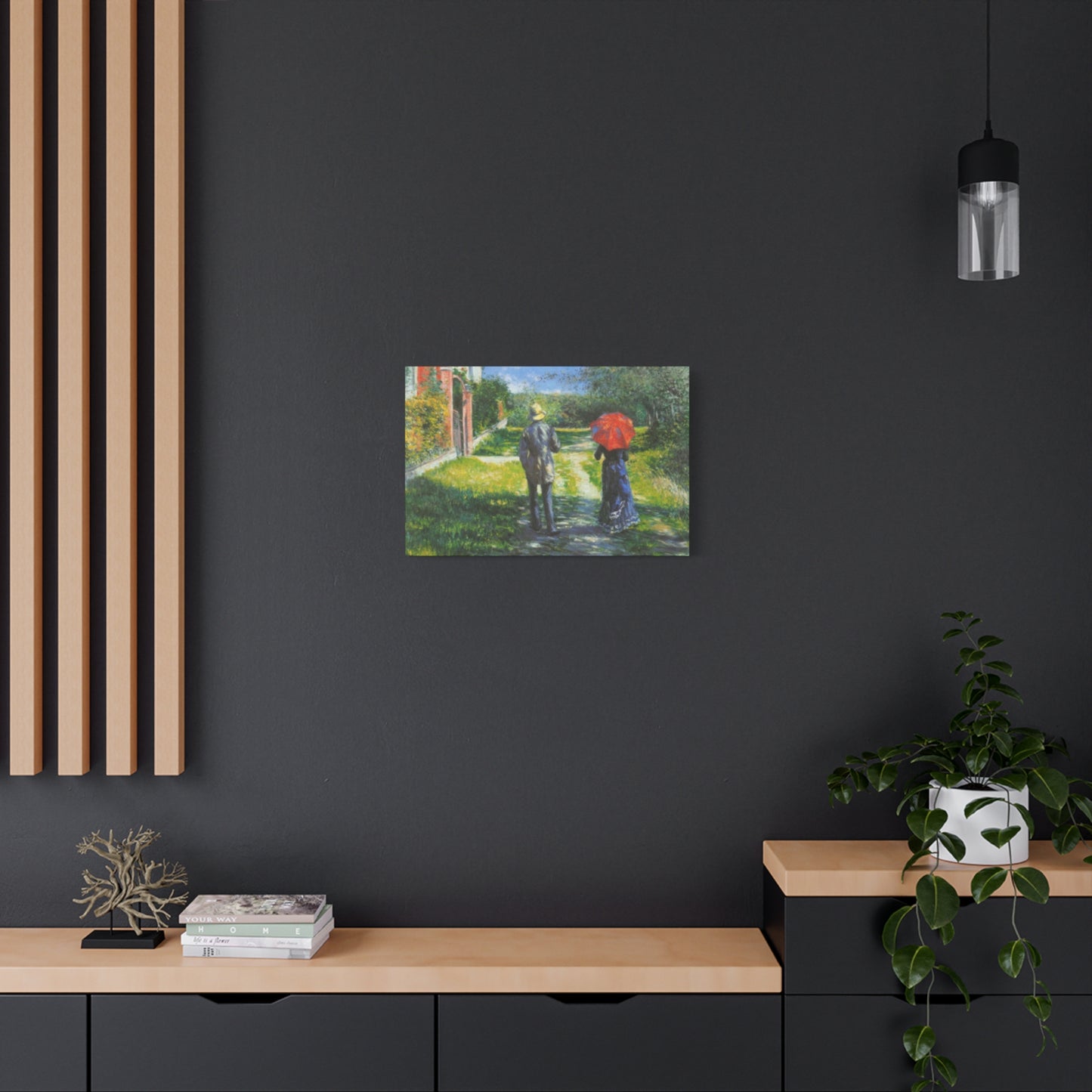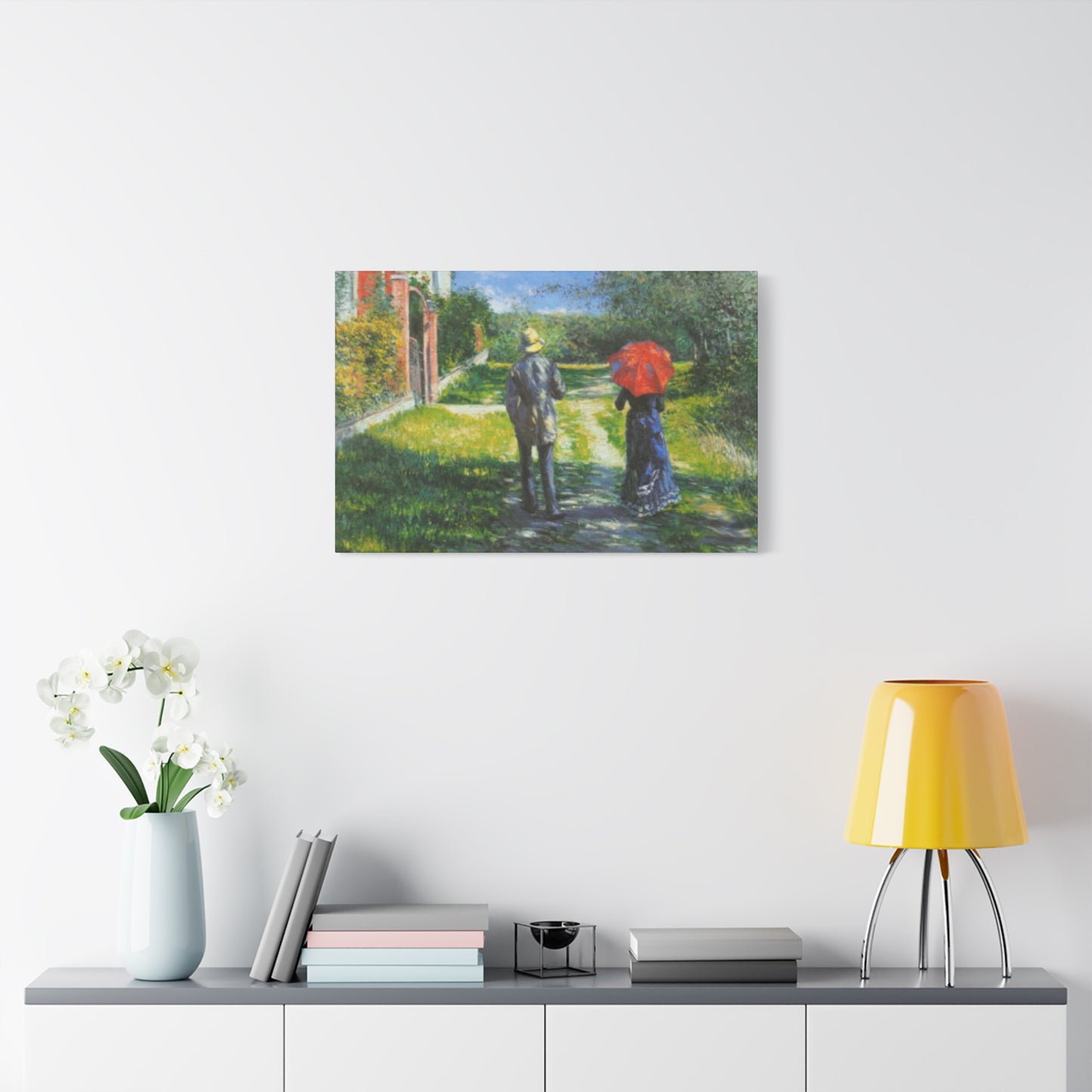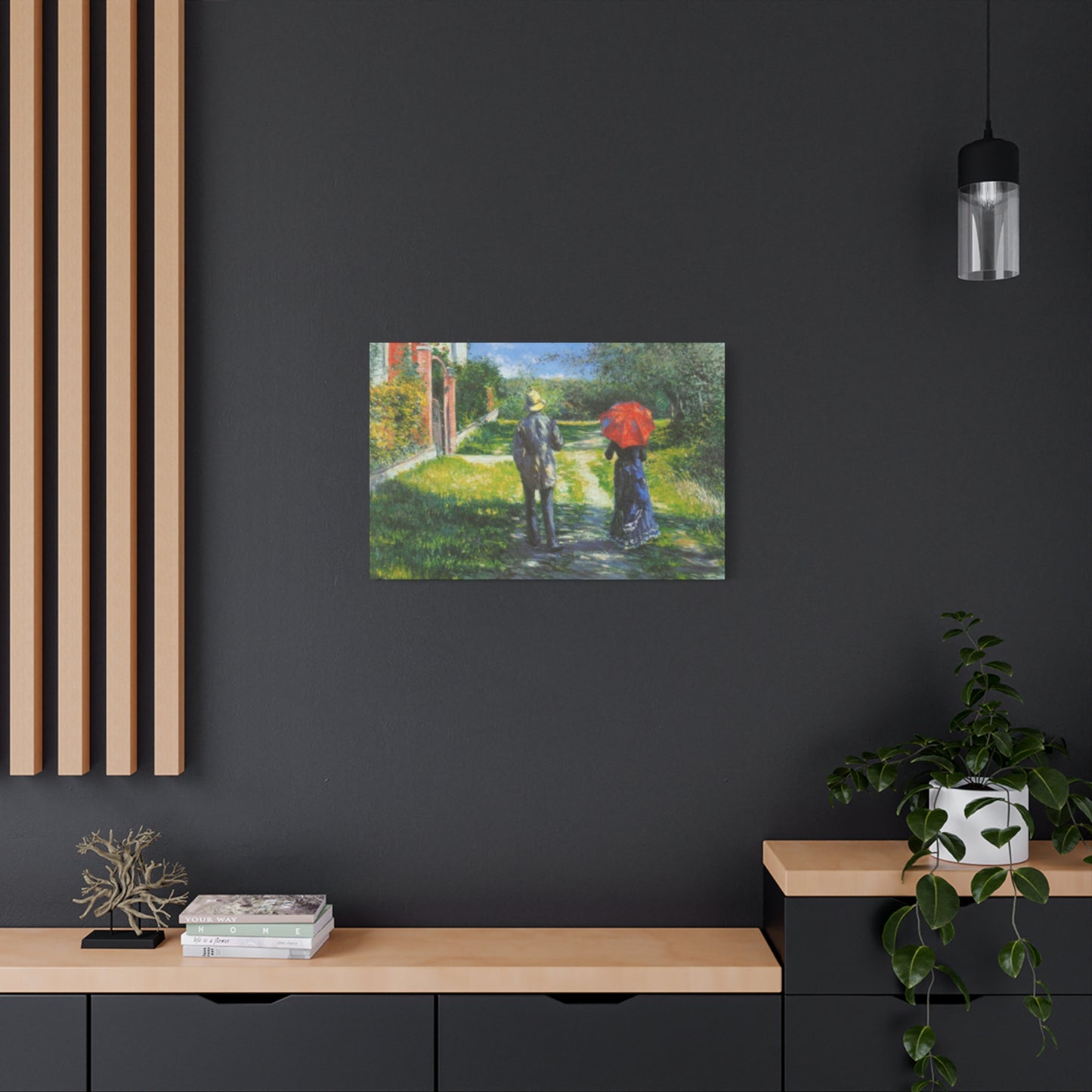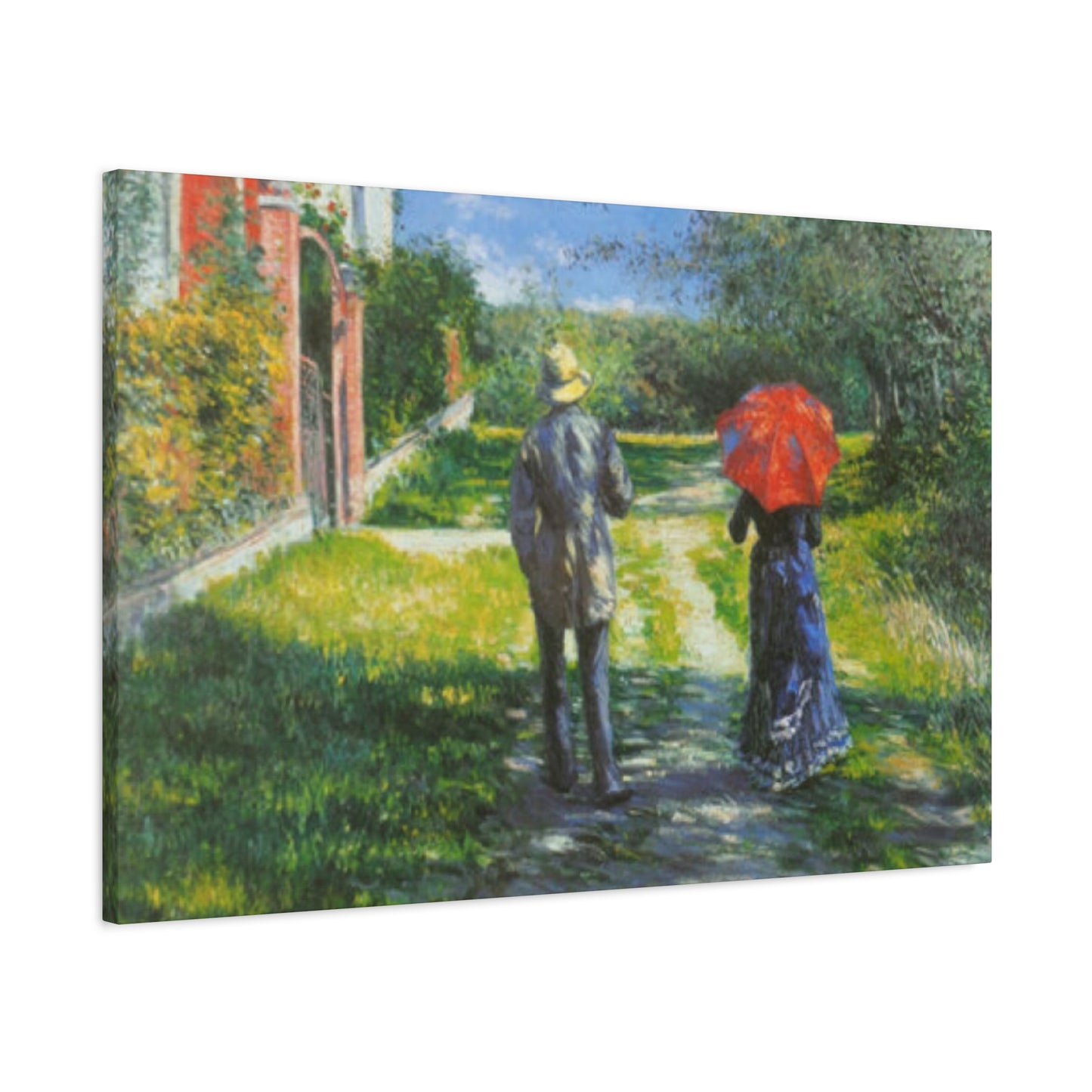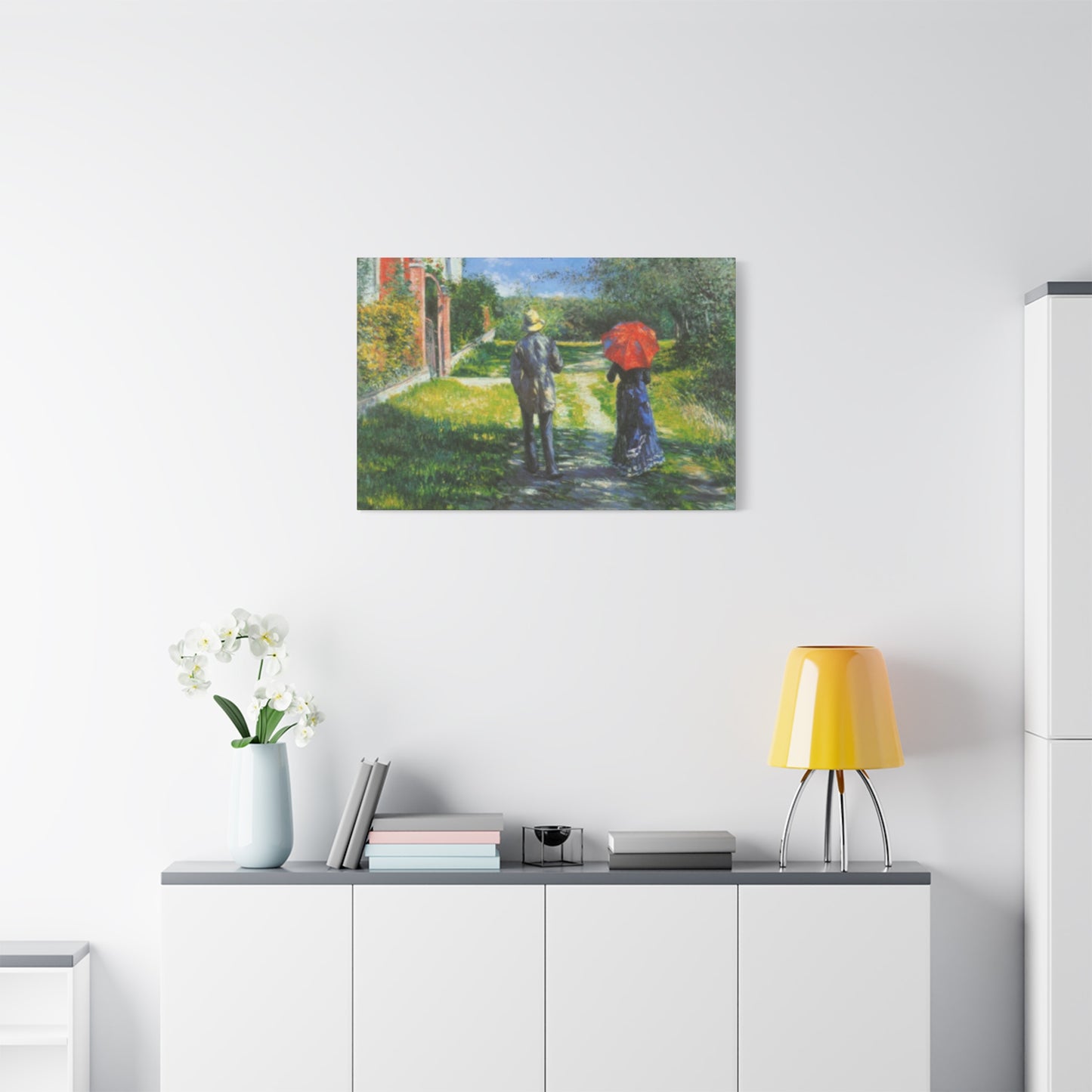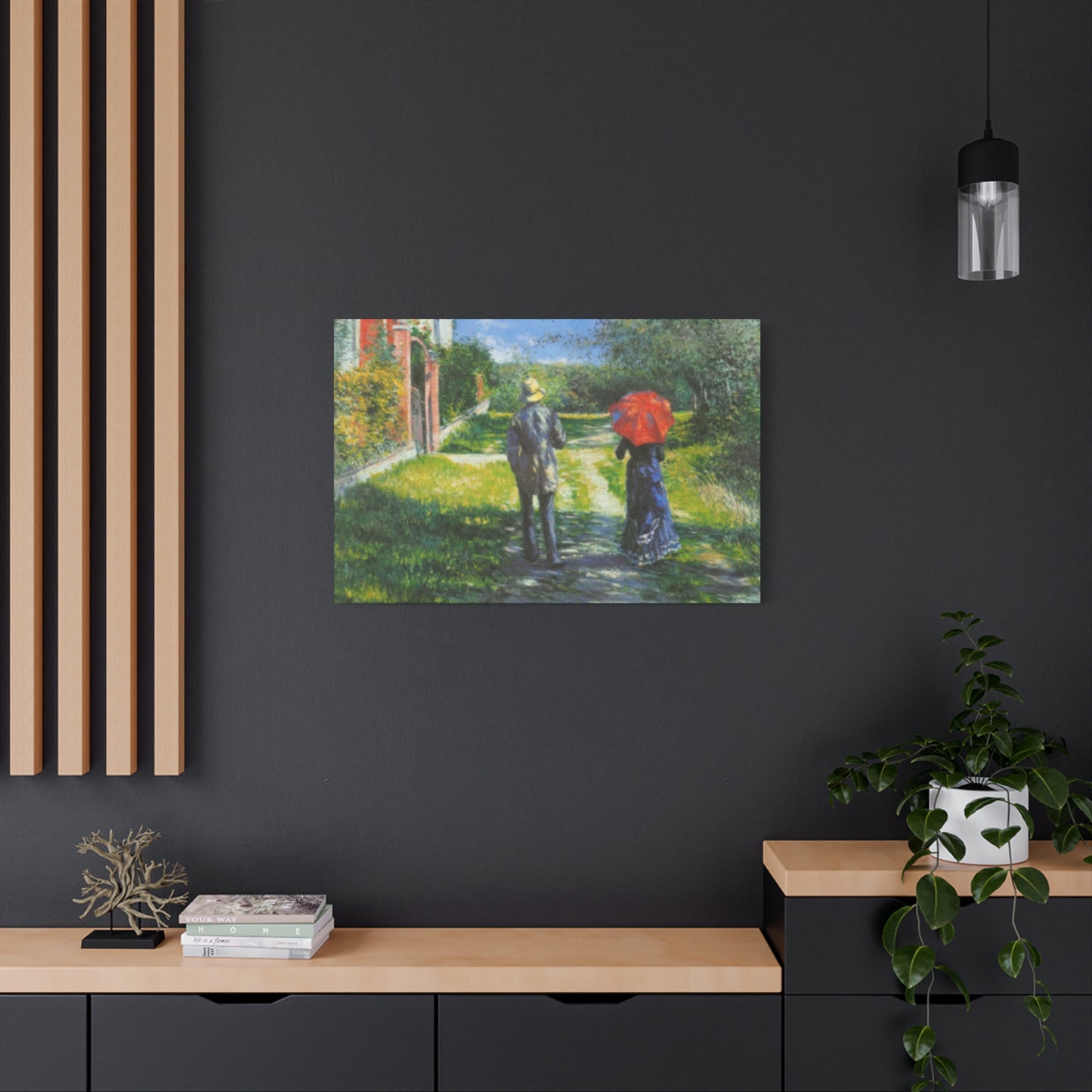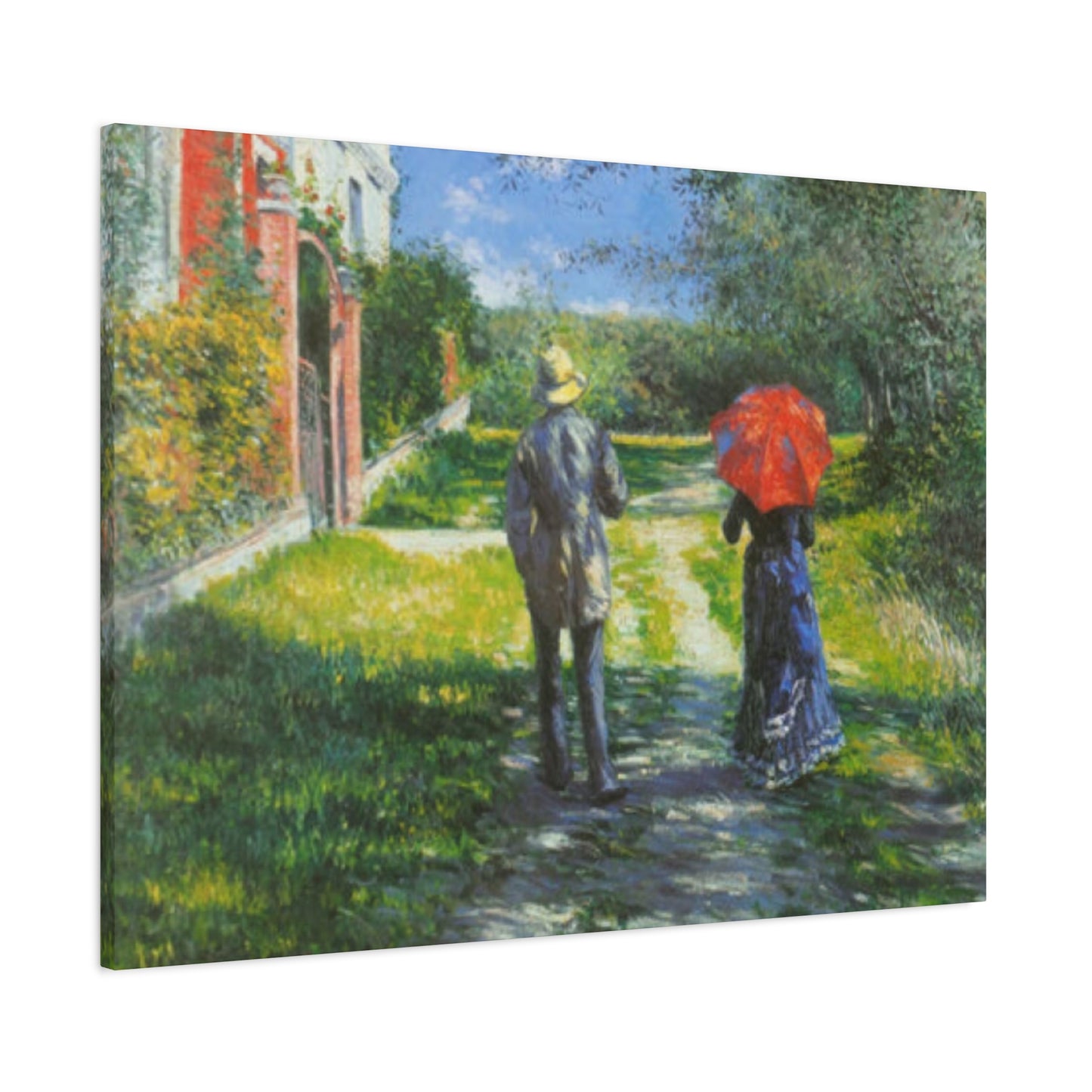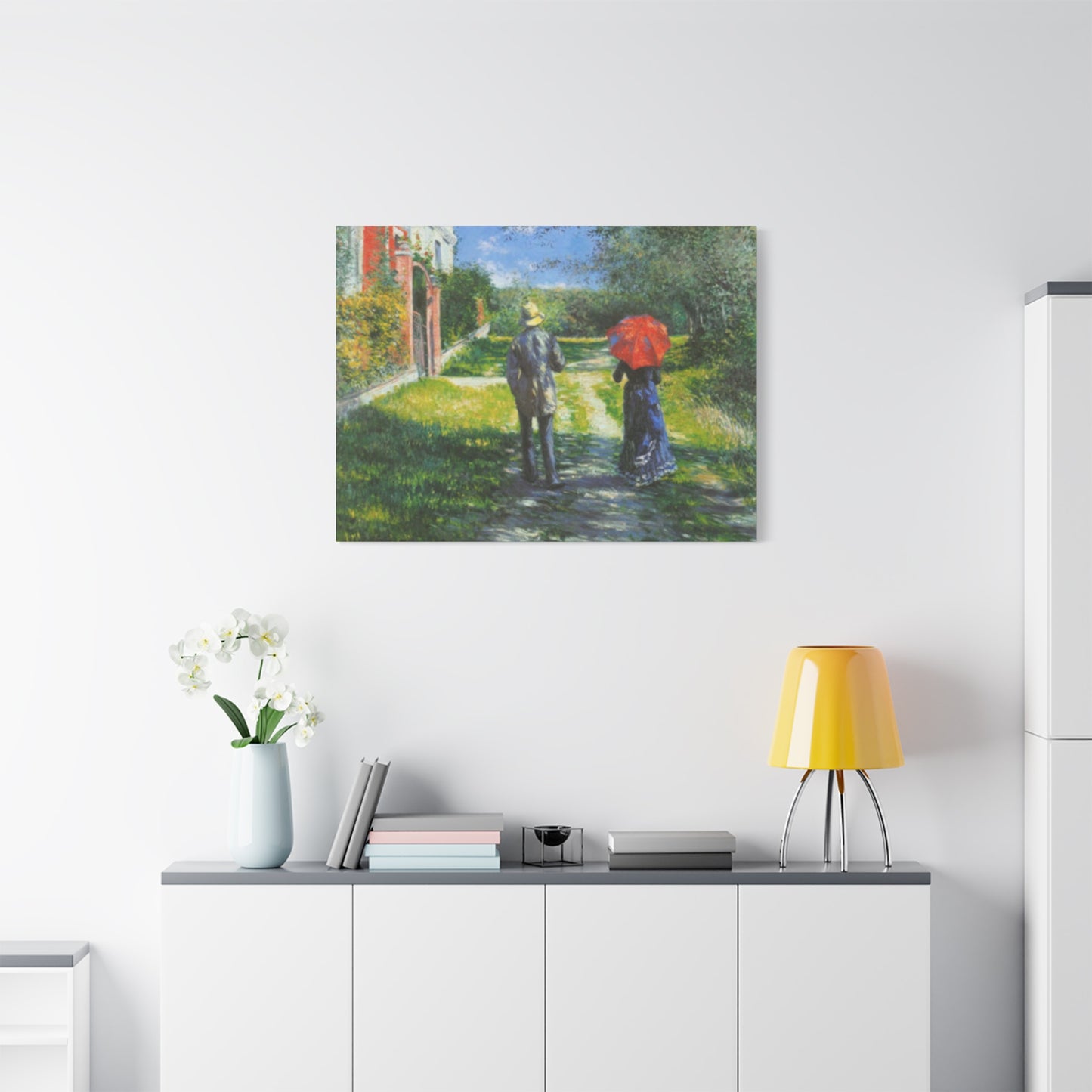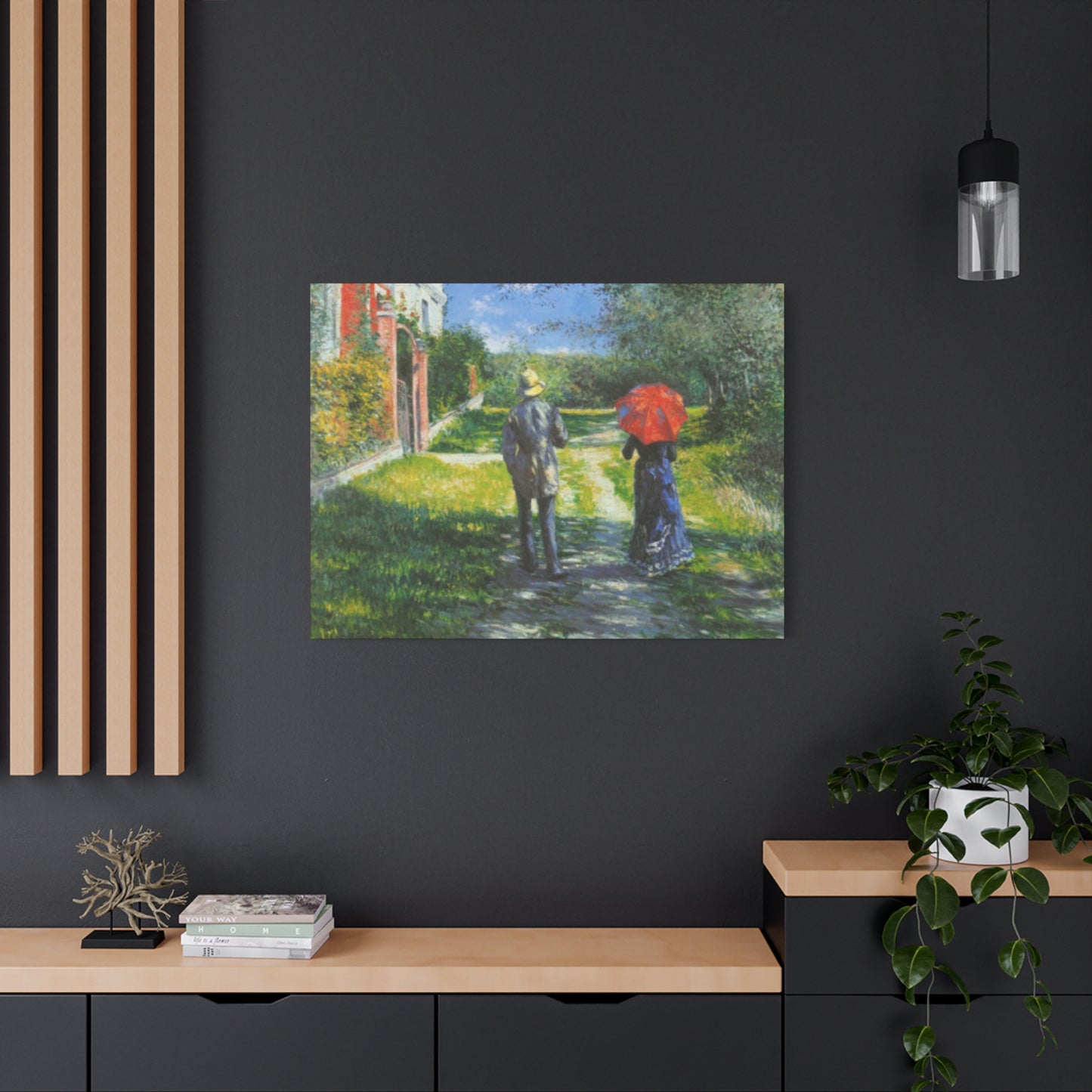Romantic Realism: The Story Behind the Walking Couple Gustav Painting Wall Art
Art has the extraordinary power to transform ordinary spaces into extraordinary sanctuaries of beauty and emotion. Among the most captivating artistic themes that continue to resonate with contemporary audiences is the romantic imagery inspired by Gustav Klimt's masterful work, particularly pieces featuring walking couples enveloped in golden elegance and intimate connection. These canvas prints have become increasingly popular in modern interior design, offering a perfect blend of classical sophistication and emotional depth that speaks to the human desire for beauty, romance, and artistic expression in our living spaces.
The enduring appeal of romantic couple artwork stems from its ability to capture universal themes of love, partnership, and human connection in visually stunning compositions. When we bring such artwork into our homes, offices, or commercial spaces, we're not merely decorating walls but creating emotional anchors that reflect our values, aspirations, and aesthetic sensibilities. The walking couple motif, particularly when rendered in the distinctive style associated with Art Nouveau and Symbolist movements, offers viewers a window into a world where romance is elevated to artistic perfection, where every brushstroke conveys passion, and where the simple act of two people walking together becomes a profound statement about human relationships.
This comprehensive guide explores every facet of incorporating romantic canvas art into your living and working environments. Whether you're a seasoned art collector, an interior design enthusiast, or someone simply looking to add meaningful beauty to your surroundings, understanding the nuances of selecting, displaying, and caring for these artistic treasures will help you make informed decisions that enhance your spaces for years to come. From understanding the historical context and symbolism embedded in these works to practical considerations about sizing, placement, and maintenance, we'll journey through the complete landscape of romantic wall art that celebrates love and partnership.
The world of canvas art reproduction has evolved dramatically in recent years, with technological advances allowing for museum-quality prints that capture the texture, color depth, and emotional impact of original paintings. This democratization of art has made it possible for anyone to bring gallery-worthy pieces into their homes without the prohibitive costs associated with original works or limited-edition prints. The romantic walking couple theme, with its timeless appeal and versatile aesthetic, has emerged as one of the most sought-after subjects in this realm, bridging the gap between classical art appreciation and contemporary decorating needs.
Choosing Walking Couple Gustav Canvas Prints
Selecting the perfect walking couple canvas print requires careful consideration of multiple factors that will determine how well the artwork integrates with your existing space and personal aesthetic. The first consideration should always be the quality of the reproduction itself, as this directly impacts both the visual appeal and the longevity of your investment. High-quality canvas prints utilize advanced printing technologies that can capture the subtle gradations of color, the intricate details of ornamentation, and the textural qualities that make the original works so compelling. When examining potential purchases, look for prints that use archival-quality inks, which resist fading and maintain their vibrancy even when exposed to indirect sunlight over extended periods.
The canvas material itself deserves close attention, as not all canvases are created equal. Premium options typically feature tightly woven cotton or linen blends that provide a stable, archival foundation for the printed image. The weave of the canvas should be fine enough to support detailed imagery without visible pixelation or distortion, yet substantial enough to maintain structural integrity when stretched over the frame. Many superior reproductions also incorporate a protective coating that shields the surface from dust, moisture, and minor abrasions while maintaining the matte finish characteristic of fine art paintings.
Framing options represent another critical decision point when selecting your canvas print. Traditional stretched canvas offers a clean, contemporary presentation where the image wraps around the edges of the frame, creating a gallery-wrapped appearance that requires no additional framing. This approach works particularly well for romantic imagery, as it allows the artwork to float on the wall without visual interruption. Alternatively, you might consider prints that come with ornate frames or the option to add custom framing later, which can enhance the classical feel of the artwork and provide additional protection for the canvas edges.
The size of your walking couple print should be determined by both the physical dimensions of your intended display space and the visual impact you wish to achieve. A common mistake is selecting artwork that is too small for the wall, which can make the piece appear lost and diminish its emotional resonance. As a general guideline, artwork should occupy approximately two-thirds to three-quarters of the available wall space above furniture pieces, creating a balanced composition that anchors the room without overwhelming it. For standalone wall displays, consider how the artwork relates to the room's overall proportions and architectural features.
Color palette compatibility is essential when choosing romantic canvas art for specific spaces. The golden hues, warm ambers, and rich jewel tones commonly found in works inspired by the Art Nouveau period can dramatically influence the atmosphere of a room. Consider how these colors will interact with your existing furnishings, wall colors, and decorative elements. While complementary colors create harmony, strategic use of contrast can make the artwork pop and become a true focal point. Many successful installations feature walking couple prints as the inspiration for an entire room's color scheme, with textiles, accessories, and accent pieces drawing from the artwork's palette.
Romantic Gustav Wall Art Ideas
Creating a romantically charged atmosphere through wall art inspired by the golden elegance of Art Nouveau requires thoughtful planning and creative vision. The distinctive characteristics of this artistic period, with its flowing lines, ornamental patterns, and celebration of feminine beauty and natural forms, offer endless possibilities for establishing spaces that feel both timeless and emotionally resonant. One compelling approach involves creating a central focal point around a large-scale walking couple print, then building the room's entire aesthetic around the colors, textures, and emotional tone of that piece. This strategy ensures cohesion and allows the artwork to truly anchor the space.
Another sophisticated approach to incorporating romantic wall art involves the strategic layering of multiple pieces in varying sizes to create visual depth and narrative complexity. Rather than relying on a single large statement piece, this method employs several smaller to medium prints arranged in a deliberate composition that guides the viewer's eye through a visual journey. You might combine different scenes from the same artistic period or style, creating connections between pieces through color harmony, compositional echoes, or thematic continuity. This approach works particularly well in larger rooms or open-concept spaces where multiple wall surfaces benefit from coordinated artistic treatment.
The integration of romantic artwork with architectural features of your space can dramatically enhance both the art and the architecture. Consider positioning walking couple prints above mantels, within alcoves, or flanking doorways to create framed vignettes that highlight both the artwork and the structural elements of the room. The interplay between classical architectural details and romantic imagery can be particularly striking, especially in homes with period features like crown molding, wainscoting, or built-in bookcases. The artwork becomes part of the architectural narrative rather than simply decoration applied to walls.
Decorating with Walking Couple Canvas Art
The art of decorating with walking couple canvas prints extends far beyond simply hanging a picture on a wall. It involves understanding spatial relationships, color theory, emotional resonance, and the subtle ways that visual elements interact to create cohesive, meaningful environments. Begin by assessing the room's existing characteristics: its natural light exposure, architectural features, color palette, and functional purpose. These foundational elements should guide your decisions about which walking couple artwork to select and where to position it for maximum impact.
The relationship between furniture arrangement and wall art placement deserves careful consideration. In living rooms, walking couple prints often work best positioned above primary seating areas, creating a visual anchor that draws people together and establishes conversation zones. The artwork should be positioned at eye level when seated, typically placing the center of the image approximately forty-two to forty-eight inches from the floor. This height creates optimal viewing conditions and makes the artwork feel integrated with the furniture grouping rather than floating disconnected on the wall.
Bedroom decorating with romantic couple imagery requires sensitivity to the intimate nature of the space. Walking couple prints positioned above the headboard create a romantic focal point that sets the emotional tone for the room. The artwork should be substantial enough to balance the visual weight of the bed, typically spanning at least half to two-thirds of the headboard width. Consider how the imagery will appear from various vantage points in the room, including from the bed itself, as you'll be viewing it frequently from multiple angles. The colors should promote relaxation and romance rather than stimulation or distraction.
Dining room applications of walking couple art transform meals into more memorable occasions by creating an atmosphere of elegance and romance. Positioning artwork on the wall facing the table allows diners to enjoy the imagery throughout their meal, making it a conversation starter and visual focal point. The romantic themes can elevate everyday dining experiences and create special ambiance for celebrations and entertaining. Consider how candlelight or dimmed overhead lighting will interact with the artwork during evening meals, as warm lighting enhances the golden tones characteristic of Art Nouveau-inspired pieces.
Hallways and transitional spaces benefit tremendously from the addition of walking couple artwork, transforming potentially overlooked areas into gallery-like experiences. These spaces offer opportunities to display multiple pieces in sequence, creating a narrative journey as one moves through the home. The flowing, dynamic quality of walking couple imagery naturally complements the linear nature of hallways, and the romantic themes can create pleasant anticipation as one moves from public to private spaces within the home.
The Elegance of Gustav-Inspired Paintings
The distinctive elegance that characterizes paintings inspired by Gustav Klimt's artistic vision stems from a unique combination of technical mastery, symbolic depth, and aesthetic innovation that revolutionized early twentieth-century art. Understanding what makes these works so enduringly appealing helps us appreciate why reproductions continue to captivate contemporary audiences and how to effectively incorporate them into modern living spaces. The signature golden palette, derived from Klimt's exploration of Byzantine mosaics and his fascination with precious materials, creates visual richness that transcends mere color choice to become almost sculptural in its luminosity and depth.
The ornamental patterns that characterize this artistic style represent a revolutionary fusion of decorative and fine art traditions. Rather than viewing ornamentation as secondary to representational content, these works elevate pattern to equal importance with figuration, creating compositions where abstract geometric or organic forms interweave with recognizable human figures. This approach creates visual complexity that rewards repeated viewing, as the eye discovers new details and relationships with each encounter. The intricate patterns also create rhythmic movement across the canvas surface, guiding the viewer's gaze and creating dynamic energy even in ostensibly static compositions.
The treatment of the human figure in these works balances idealization with emotional authenticity, creating subjects that feel simultaneously timeless and intimately human. Rather than striving for photographic realism, the artistic approach emphasizes expressive gesture, symbolic posture, and emotional resonance. Faces might be rendered with relative naturalism while bodies dissolve into abstract pattern, or figures might be entirely enveloped in decorative elements that suggest rather than explicitly depict physical form. This selective realism creates dreamlike quality that allows viewers to project their own emotions and experiences onto the imagery.
The philosophical and symbolic dimensions embedded in romantic couple imagery from this period reflect broader cultural conversations about love, sexuality, spirituality, and the relationship between individual and universal experience. Walking couples often symbolize life's journey undertaken in partnership, the intertwining of separate identities into unified relationships, or the navigation of earthly existence guided by love. Understanding these symbolic layers enriches appreciation and allows for more meaningful connections between the artwork and the viewer's own life experiences.
Large Gustav Canvas for Statement Walls
Statement walls have become a cornerstone of contemporary interior design, offering opportunities to create dramatic focal points that define the character and emotional tone of entire rooms. Large-scale walking couple canvas prints serve this purpose exceptionally well, combining artistic merit with visual impact that commands attention without overwhelming spaces. The key to successfully deploying large romantic artwork lies in understanding the relationship between image scale, wall dimensions, and surrounding design elements to create balanced compositions that feel intentional rather than arbitrary or excessive.
The psychological impact of large-scale artwork differs significantly from smaller pieces, creating immersive experiences that can transport viewers into the emotional and aesthetic world of the image. A substantial walking couple print occupying a prominent wall position becomes more than decoration; it establishes the room's identity and creates a memorable impression on anyone entering the space. This transformative power makes large canvas art particularly effective in spaces designed to impress, inspire, or create specific emotional atmospheres, from formal living rooms to romantic bedroom retreats.
Selecting the right wall for a large statement piece requires careful evaluation of your space's architecture and traffic patterns. The ideal statement wall is typically the first wall visible when entering the room, lacks competing architectural features like windows or doors, and has sufficient dimensions to accommodate substantial artwork without appearing cramped. In open-concept spaces, statement walls can also serve as visual dividers that help define separate functional zones while maintaining spatial flow. The wall should have adequate lighting, either natural or artificial, to properly illuminate the artwork and allow its details to be appreciated.
The technical considerations for mounting large canvas prints differ from smaller pieces and may require specialized hardware to ensure safe, secure installation. Heavy artwork demands anchoring into wall studs or using appropriate wall anchors rated for the canvas weight, including the frame. Professional installation may be warranted for particularly large or valuable pieces, ensuring proper positioning and eliminating the risk of damage to both the artwork and the wall. Consider the permanent nature of drilling large mounting holes when selecting your statement wall location, as relocating large artwork typically requires wall repair and repainting.
Small Romantic Prints for Cozy Spaces
While large statement pieces command attention through sheer scale, small romantic prints offer their own unique advantages for creating intimate, personal spaces that feel collected and curated rather than decorated with broad strokes. Walking couple artwork in modest dimensions can inhabit spaces where larger pieces would overwhelm, allowing you to bring romantic elegance into cozy nooks, compact rooms, or alongside other decorative elements in more complex arrangements. The key to successfully incorporating small prints lies in strategic placement, thoughtful grouping, and attention to the relationship between artwork and its immediate surroundings.
The intimate viewing experience created by small romantic prints encourages close engagement with the artwork, inviting viewers to approach and examine details that might be missed at a distance. This quality makes small prints particularly effective in spaces where people naturally pause and linger: reading corners, bedside tables, bathroom vanities, or beside comfortable seating. The artwork becomes a companion to quiet moments, its romantic imagery creating subtle emotional atmosphere without demanding attention the way larger pieces inevitably do.
The affordability of small prints makes them accessible entry points for beginning collectors or those decorating on limited budgets. Rather than investing substantially in a single large piece, you might acquire several small walking couple prints, either all at once or gradually over time, building a collection that can be displayed together or rotated seasonally. This approach allows for experimentation with different images, styles, and arrangements without major financial commitment, and provides flexibility to adapt your decorating as tastes evolve or living situations change.
Grouping small romantic prints creates visual impact that rivals larger single pieces while offering compositional flexibility. Gallery wall arrangements combining multiple small walking couple images with complementary artwork, mirrors, or decorative objects can fill substantial wall space with personality and interest. The arrangement itself becomes an art form, with careful attention to spacing, alignment, and visual rhythm creating cohesive compositions from disparate elements. Consider whether you prefer symmetrical arrangements with formal balance or asymmetrical compositions that feel more organic and dynamic.
The framing of small prints becomes proportionally more important than with larger pieces, as the frame constitutes a greater percentage of the total visual presentation. Ornate frames can overwhelm small images, while overly minimal framing may fail to give the artwork sufficient presence. Generally, frame width should be proportional to image size, with mats providing breathing room between image and frame. Consistent framing across multiple small prints creates cohesion in grouped arrangements, though intentional variation can add visual interest if carefully executed with attention to overall balance.
Small walking couple prints excel in transitional spaces and unexpected locations where larger artwork would be impractical or disproportionate. Consider narrow walls flanking doorways, small sections of wall between windows, or vertical spaces alongside built-in features where a carefully chosen small print adds visual interest without overwhelming the limited space. These unexpected placements can create delightful discoveries throughout your home, moments of beauty that reward attention and make even utilitarian spaces feel considered and intentional.
Custom Walking Couple Art Options
The availability of custom artwork options has revolutionized how people can incorporate personalized romantic imagery into their homes, moving beyond standard reproductions to create unique pieces that reflect individual relationships and aesthetic preferences. Custom walking couple art encompasses a spectrum of possibilities, from minor modifications to existing designs through color adjustments or size variations, to completely original commissions that capture specific couples in distinctive artistic styles. Understanding the landscape of customization options helps you determine which approach best serves your vision and budget while creating artwork that holds deep personal significance.
Personalized portraits depicting actual couples in the romantic style inspired by Art Nouveau represent the ultimate customization, transforming you and your partner into the subjects of elegant, timeless artwork. Artists specializing in this approach typically work from photographs, translating the likeness and relationship dynamic into the flowing lines, golden palettes, and ornamental patterns characteristic of the style. The result is artwork that combines the universal appeal of romantic couple imagery with the intimate specificity of your own relationship, creating a truly one-of-a-kind piece that serves as both art and personal memento.
Color customization of existing walking couple compositions offers a more accessible form of personalization, allowing you to adapt artwork to your specific decorating needs while maintaining the essential composition and aesthetic of the original. You might request a version with cooler color temperatures to suit a contemporary color scheme, or emphasize certain hues that appear in your existing furnishings and decor. This approach provides the benefits of proven compositions and artistic quality while ensuring the finished piece integrates seamlessly with your particular space.
Size customization addresses one of the most common challenges in art selection: finding pieces in dimensions that properly fit your available wall space. Rather than compromising with imperfect sizing from standard offerings, custom printing allows you to specify exact dimensions that optimize the relationship between artwork and architectural features. This precision ensures your walking couple canvas appears intentionally scaled for its location rather than awkwardly too large or disappointingly too small. However, be mindful of resolution limitations that can affect quality when scaling images beyond their intended dimensions.
Text and inscription additions can transform walking couple artwork into commemorative pieces perfect for weddings, anniversaries, or as gifts celebrating relationships. Consider incorporating names, dates, meaningful quotes, or personal messages into the composition, either as visible design elements or more subtly integrated into the artwork. The typography and placement of text should complement rather than compete with the romantic imagery, enhancing the emotional resonance while maintaining aesthetic harmony. Work with designers who understand both typography and composition to ensure additions enhance rather than detract from the finished piece.
Mixing Romantic Art with Modern Decor
The seemingly paradoxical combination of romantic, historically-inspired artwork with contemporary interior design creates dynamic, layered spaces that feel both timeless and current. Successfully integrating walking couple canvas prints into modern decor requires understanding the principles that allow disparate aesthetic elements to coexist harmoniously rather than creating jarring, incoherent visual environments. The key lies in identifying shared qualities between classical romantic art and modern design that can serve as bridges connecting the two aesthetics into unified wholes.
Color serves as one of the most effective connection points between romantic artwork and contemporary interiors. While the golden hues and rich jewel tones characteristic of Art Nouveau-inspired pieces might seem antithetical to the neutral palettes favored in minimalist modern design, strategic use of these warm tones as accent colors creates visual links that unify the space. A predominantly white or gray contemporary room can be warmed and humanized by a romantic walking couple print, with the artwork's colors pulled through in smaller doses via throw pillows, artwork mats, or decorative objects. This approach allows the romantic piece to function as a jewel-like focal point against the restrained backdrop.
Contrast as an intentional design strategy celebrates the differences between romantic and modern rather than attempting to minimize them. A ornately detailed, pattern-rich walking couple canvas gains even greater impact when displayed against stark white walls in a space with clean-lined, minimalist furniture. The juxtaposition highlights the unique qualities of both the artwork and the contemporary setting, creating visual interest through opposition rather than harmony. This approach appeals to confident decorators willing to embrace eclecticism and tension as positive design elements.
Scale relationships become particularly important when mixing ornate romantic artwork with modern interiors, as contemporary design often emphasizes generous negative space and uncluttered surfaces. Oversized walking couple prints can hold their own in modern spaces by occupying substantial wall area that commands attention despite competing simplicity elsewhere in the room. The artwork's scale prevents it from being diminished by the surrounding austerity while the clean backdrop allows the piece's complexity to be fully appreciated without visual competition.
Framing choices significantly influence how successfully romantic canvas art integrates with modern decor. Traditional ornate frames can feel discordant in contemporary spaces, while simple, clean-lined frames or frameless gallery-wrapped presentations allow the artwork itself to communicate period character without reinforcing it through the frame. Floating frames in metallic finishes can bridge classical and contemporary by providing definition and presence while maintaining visual lightness. Consider whether the frame should defer to the artwork or actively contribute to bridging aesthetic periods.
Furniture style provides another opportunity to create connections between romantic art and modern spaces. Mid-century modern furniture, with its organic curves and warm wood tones, naturally complements Art Nouveau-inspired artwork despite belonging to different historical periods. Contemporary pieces in warm metals like brass or copper echo the golden tones in romantic canvas prints. Even strictly modern furniture can be styled with textiles or accessories that pick up colors or patterns from the artwork, creating subtle visual threads that tie the room together.
Office Walls with Gustav-Inspired Prints
The integration of romantic walking couple artwork into office environments might initially seem counterintuitive, given the professional, productivity-focused nature of workspaces. However, thoughtful incorporation of beautiful, emotionally resonant art into offices creates more humane, inspiring environments that can actually enhance productivity, creativity, and overall well-being. Understanding how to select and display romantic canvas prints in professional contexts requires balancing aesthetic appeal with workplace appropriateness, ensuring the artwork enriches the environment without creating distraction or seeming incongruous with professional activities.
Home office applications of walking couple art offer the most flexibility, as these spaces blend professional function with personal expression. Romantic canvas prints in home offices serve multiple purposes: they create visual interest during video calls, provide pleasant focal points for breaking up long work sessions, and help maintain psychological separation between work mode and the rest of home life. Position artwork where it will be visible in video call backgrounds but not directly behind where you sit, creating depth and interest without overwhelming your image on screen. The presence of beautiful art in your workspace becomes a small luxury that makes work-from-home arrangements feel more intentional and pleasant.
Corporate office environments require more restrained approaches to romantic artwork, with consideration for professional image, diverse employee preferences, and workplace culture. Walking couple prints in office settings work best when they emphasize the artistic and aesthetic qualities rather than overtly romantic content. Choose images where the artistic style, color palette, and composition take precedence over romantic narrative, allowing the pieces to function as sophisticated art rather than personal expressions of romantic sentiment. Reception areas, conference rooms, and executive offices offer appropriate locations for more distinctive artwork that makes memorable impressions on clients and visitors.
The psychological benefits of art in workspaces have been extensively documented, with research demonstrating that visually interesting environments reduce stress, enhance creative thinking, and improve overall job satisfaction. Walking couple artwork with its harmonious compositions, flowing lines, and generally optimistic emotional tone creates subtle positive psychological effects that accumulate over time. The artwork provides momentary mental breaks when employees glance away from screens, offering visual rest that reduces eye strain and mental fatigue. The presence of beauty in work environments communicates that the organization values employee wellbeing beyond mere productivity metrics.
Color psychology principles inform strategic selection of romantic artwork for office spaces based on the type of work performed and the atmosphere you wish to establish. The golden, warm tones characteristic of Art Nouveau-inspired pieces create welcoming, energizing environments appropriate for collaborative spaces, creative departments, or client-facing areas. Cooler variations of walking couple imagery might better suit spaces requiring calm concentration like accounting departments, legal offices, or medical facilities. Consider how the artwork's colors will influence the psychological tone of the workspace when making selections.
Scale appropriateness in office contexts differs from residential applications, as professional spaces often feature larger wall expanses that can accommodate substantial artwork without overwhelming the environment. Conference rooms benefit from large-scale walking couple prints that create focal points and contribute to the room's sense of importance and formality. Individual offices typically suit smaller to medium-sized pieces that personalize spaces without dominating them. Open office environments require careful consideration to ensure artwork is visible and appreciated without creating sight-line obstacles or visual distraction from workstations.
Affordable Gustav Canvas Art Ideas
Bringing romantic walking couple artwork into your home need not require substantial financial investment, as numerous strategies exist for acquiring beautiful canvas prints at accessible price points. Understanding the art market, reproduction technologies, and creative sourcing options empowers budget-conscious decorators to create beautiful spaces featuring timeless romantic imagery without compromising other financial priorities. The key lies in knowing where to make strategic compromises that reduce costs without significantly sacrificing quality or aesthetic impact.
Digital print-on-demand services have revolutionized affordable art access by eliminating inventory costs and intermediaries between artists or rights holders and consumers. These platforms allow you to order walking couple canvas prints in custom sizes, often at significantly lower prices than traditional art retailers. The quality varies considerably among providers, so research reviews, request samples when possible, and understand the printing technology and materials used before committing to purchases. While these services may not match the absolute highest quality reproductions, many deliver perfectly acceptable results for decorative applications, especially when proper care is taken in file selection and size specifications.
Public domain artwork represents a treasure trove of free source material that can be printed affordably through various services or even at home if you have access to quality printing equipment. Works by artists whose copyright protections have expired can be downloaded in high resolution from museum websites, digital archives, and cultural heritage platforms. While the most famous examples of Art Nouveau romantic couple imagery may still be under copyright protection, similar period works exist in the public domain. Understanding how to locate, evaluate, and prepare these digital files for printing opens enormous possibilities for affordable custom artwork.
Timing purchases strategically around sales events, seasonal promotions, and clearance opportunities can yield significant savings on romantic canvas art. Many online and brick-and-mortar retailers offer substantial discounts during major shopping holidays, end-of-season clearances, or when discontinuing certain products. Subscribe to newsletters from art retailers whose aesthetic aligns with your taste, allowing you to receive advance notice of sales and exclusive subscriber discounts. Patience and willingness to wait for opportune timing can mean acquiring the same artwork at fraction of regular prices.
DIY printing approaches offer maximum affordability for those willing to invest time and effort into the process. Quality home inkjet printers with archival ink systems can produce acceptable canvas prints when using appropriate materials and properly prepared digital files. The initial investment in equipment and materials gets recouped across multiple projects, making this approach particularly economical for those wanting numerous pieces or planning to create gifts. However, understand that DIY results typically cannot match professional quality, and factor in the learning curve and time investment required to develop skills and refine processes.
Smaller sizes naturally cost less than large-scale prints, making this an obvious but effective affordability strategy. Rather than a single large statement piece, consider creating impact through grouped arrangements of smaller walking couple prints that collectively command attention while individually costing less. This approach also allows gradual collection building, spreading costs over time as budget permits. The cumulative visual effect can equal or exceed that of expensive large pieces while providing flexibility to rearrange, rotate, or relocate individual elements as your needs or taste evolves.
Gallery Wall Ideas with Romantic Prints
Gallery walls represent dynamic, personalized approaches to displaying art that allow for creative expression, flexibility, and the ability to create substantial visual impact from collections of individual pieces. Walking couple prints lend themselves beautifully to gallery wall arrangements, either as the exclusive focus of the composition or integrated with complementary artwork, photographs, and decorative objects. Successfully executing gallery walls requires understanding compositional principles, planning techniques, and installation methods that result in cohesive, professional-looking arrangements rather than haphazard collections of disparate elements.
The planning phase determines the success of gallery wall projects, requiring careful consideration of available wall space, the pieces you wish to include, and the overall compositional approach. Begin by inventorying your walking couple prints and any other elements you want to incorporate, documenting sizes, orientations, and framing styles. Create paper templates matching each piece's dimensions, allowing you to experiment with arrangements on the floor or temporarily tape them to the wall to visualize the final composition before committing to permanent installation. This preparatory work prevents costly mistakes and ensures your final arrangement achieves the desired balance and visual impact.
Compositional approaches for romantic print gallery walls range from strictly formal symmetrical arrangements to organic, asymmetrical compositions that feel more collected and personal. Symmetrical approaches work well in formal rooms or above centered furniture pieces like sofas or beds, creating balanced, traditional presentations with orderly spacing and aligned elements. Asymmetrical arrangements offer more flexibility and contemporary appeal, allowing you to incorporate pieces of varying sizes, shapes, and even mixed media while maintaining overall visual balance through careful attention to weight distribution and negative space. Choose the approach that best suits your space's architecture, furnishings, and overall design aesthetic.
The visual center or focal point of your gallery wall should typically be positioned at eye level, approximately fifty-seven to sixty inches from the floor to the center of the arrangement. This height standard, used in museums and galleries, ensures comfortable viewing and proper visual relationship with the room's other elements. For gallery walls above furniture, adjust this height to maintain appropriate spacing between the furniture piece and the bottom edge of the artwork, typically leaving six to twelve inches of clear space. The focal point piece is usually the largest, most visually striking, or emotionally significant element in the arrangement, with other pieces supporting and enhancing it.
Color coordination within gallery walls featuring walking couple prints can follow several successful strategies depending on your desired effect. Monochromatic approaches using prints with similar color palettes create harmonious, restful compositions that feel cohesive despite including multiple images. Rainbow or graduated color arrangements transition through the color spectrum across the wall, creating dynamic visual interest and energy. Accent color approaches feature primarily neutral pieces punctuated by walking couple prints in richer colors that become focal points within the arrangement. Consider how the overall color story of your gallery wall relates to the room's broader palette.
Frame consistency versus variety represents a key decision point in gallery wall design. Uniform framing across all pieces creates formal, cohesive appearances that emphasize the artwork itself rather than the frames. This approach works particularly well for collections of similar romantic prints or when creating symmetrical arrangements. Varied framing incorporating different styles, materials, and finishes creates more eclectic, collected-over-time appearances that add visual interest through the frames themselves. When mixing frames, maintain some unifying element such as consistent color tones, all wood or all metal frames, or similar proportions to prevent the arrangement from appearing disorganized.
Spacing between pieces significantly influences how gallery walls read visually, with close spacing creating unified field effects while generous spacing emphasizes individual pieces. For traditional gallery walls featuring romantic prints, maintain consistent spacing of two to six inches between frames, with the specific measurement determined by the overall scale of the arrangement and the pieces themselves. Larger pieces generally require slightly more generous spacing, while smaller pieces can be grouped more tightly. Use level guidelines and careful measurement to ensure spacing remains consistent throughout the arrangement, as even small variations become visually obvious once the gallery wall is complete.
Integration of three-dimensional objects adds depth and tactile interest to gallery walls featuring walking couple prints. Consider incorporating decorative plates, mirrors, sculptural objects, or wall-mounted shelves displaying small treasures within your arrangement of canvas art. These dimensional elements break up the flatness of two-dimensional artwork while creating opportunities for personal expression through meaningful objects. Ensure three-dimensional elements relate visually to the artwork through color, style, or theme rather than appearing as random additions that disrupt the composition.
Statement Pieces: Walking Couple Canvas
Statement pieces represent bold decorating choices that define spaces and create memorable impressions through artistic merit, visual impact, or emotional resonance. Walking couple canvas prints possess inherent qualities that make them effective statement pieces: the timeless romantic subject matter, the distinctive aesthetic associated with Art Nouveau styling, and the general cultural recognition of the artistic tradition they represent. Successfully deploying romantic canvas art as statement pieces requires understanding what differentiates true statements from mere decoration and how to support your chosen piece so it achieves its full impact within your space.
The scale requirement for effective statement pieces generally demands substantial physical presence, as artwork must command attention through sheer size to function as true statements rather than supporting decoration. For walking couple canvas art to serve as a statement piece, it typically needs to measure at least forty inches in one dimension, with larger sizes creating even more dramatic impact. However, scale is not purely about physical dimensions but also about visual weight determined by color intensity, compositional complexity, and the artwork's relationship to surrounding elements. A moderately sized piece with powerful imagery and bold colors can function as a statement while a physically larger but visually quieter piece might recede into the background.
Positioning determines whether artwork achieves statement status or gets relegated to decorative supporting role. Statement pieces demand primary wall positions where they become focal points that organize the room's visual hierarchy. This typically means the first wall visible when entering the space, positioned centrally above key furniture pieces, or in locations where architectural features like fireplaces, archways, or windows frame the artwork. Avoid tucking potential statement pieces into corners, flanking them with competing visual elements, or placing them where sightlines are obstructed. The artwork should announce itself clearly and immediately as important.
The support system surrounding your walking couple statement piece either enhances its impact or diminishes it through poor coordination. Furniture arrangement should direct attention toward rather than away from the artwork, with seating oriented to facilitate viewing and circulation paths that naturally draw occupants into relationship with the piece. Avoid placing tall furnishings or room dividers that obstruct views of the artwork from major areas of the room.
Textured Gustav Wall Art Trends
Contemporary approaches to reproducing romantic walking couple imagery increasingly emphasize textural dimension that adds physical presence and tactile interest to canvas prints. These textured reproductions attempt to capture not just the visual appearance of paintings but also the physical characteristics of brushstrokes, impasto techniques, and surface variations that give original artworks their distinctive character. Understanding current trends in textured wall art helps consumers make informed choices about which approach best serves their aesthetic preferences and how different texturing techniques impact the artwork's appearance and longevity.
Gel medium applications represent one popular approach to creating texture in canvas reproductions, involving the application of clear or tinted acrylic gels over printed surfaces to build dimensional brushstroke effects. Skilled application creates convincing simulations of painting techniques, adding visual and tactile interest that elevates prints beyond flat photographic reproductions. The gel catches light differently across its varied surface, creating subtle plays of highlight and shadow that animate the artwork as viewing angles and lighting conditions change. However, quality varies enormously in gel-textured reproductions, with inferior applications appearing obviously artificial or failing to align properly with the underlying printed imagery.
Embossing techniques create texture through mechanical processes that raise and lower canvas surfaces according to the composition's brushwork patterns. This approach can produce remarkably consistent results across multiple reproductions and typically costs less than hand-applied gel techniques. The texture, while not as pronounced as heavy gel application, adds sufficient dimension to clearly differentiate the piece from flat printing while maintaining the durability and consistency expected in commercial art production. Advanced embossing methods can create nuanced texture variations that respond to the specific characteristics of individual compositions rather than applying generic patterns.
Mixed media approaches combine printing with actual painting elements, creating hybrid works that include both reproduced imagery and original artistic application. An artist might print the basic composition onto canvas, then add hand-painted highlights, additional gold leaf, or painted borders that make each piece unique while keeping costs manageable through the printed foundation. These works occupy interesting territory between reproductions and originals, offering some uniqueness and handcrafted quality at intermediate price points. For walking couple artwork where golden elements feature prominently, the addition of actual metallic paint or gold leaf can dramatically enhance the piece's luxurious character.
Three-dimensional surface building through multiple printing passes layered with varnishes or coatings creates texture purely through the accumulation of materials without relying on hand application or embossing. This digital approach offers excellent consistency and can be fully automated for efficiency, though the resulting texture tends to be subtler than manually applied techniques. The advantage lies in precision and repeatability, ensuring that every reproduction maintains identical textural characteristics. For large-scale production or situations where consistency across multiple pieces matters, this technology-driven approach offers compelling benefits.
Conclusion
Romantic Realism: The Story Behind the Walking Couple Gustav Painting Wall Art captures more than the quiet elegance of two figures sharing a tranquil moment—it encapsulates the enduring beauty of human connection through Gustav Klimt’s evocative blend of realism and romantic symbolism. This artwork is not merely a visual masterpiece; it is a story of intimacy, movement, and timeless emotion, embodied in color, form, and composition. The Walking Couple represents the subtle poetry of companionship—an eternal dance between individuality and togetherness, rendered in Gustav’s uniquely textured brushwork and his signature harmony of pattern and tone.
At its essence, the painting conveys the serenity of shared paths. The couple, side by side, walks through an environment alive with both mystery and calm—an allegory for love’s journey. The interplay of light and shadow gives life to the figures, while Gustav’s delicate attention to detail conveys authenticity, grounding the romantic idealism of the scene in tangible human emotion. It is a moment frozen in time, yet endlessly relevant—a depiction that transcends eras, reminding viewers of the quiet, profound moments that define relationships.
This union of romantic sentiment and realistic depiction is what gives the Walking Couple its universal resonance. Gustav’s approach to realism does not seek perfection in physical form, but rather the perfection of emotional truth. Each brushstroke reveals his fascination with the tender balance between individuality and unity—between the solitary act of walking and the shared experience of companionship. His use of earthy, muted colors creates warmth and depth, while the careful blending of the couple’s forms with their surroundings blurs the line between human presence and the natural world.
When transformed into wall art, this piece transcends its historical origins and becomes an emotive statement within modern interiors. The Walking Couple Gustav Painting Wall Art carries both sophistication and soul, making it a perfect focal point for contemporary spaces that seek to combine aesthetic depth with emotional warmth. Hung above a living room sofa, along a hallway, or in a bedroom, it transforms walls into reflections of intimacy and artistic refinement. The calm palette harmonizes effortlessly with neutral tones, soft lighting, and minimalist décor, while the emotional depth of the imagery adds balance to more modern, structured designs.
In modern interior design, art inspired by Gustav’s romantic realism invites introspection and serenity. The painting’s gentle rhythm and subdued hues evoke peace and stability, offering viewers a visual retreat from the fast pace of modern life. Its timeless quality complements various décor themes—from classic European elegance to contemporary minimalism—proving that true romantic art transcends stylistic boundaries. The image of the walking couple resonates with themes of partnership, patience, and shared dreams, turning any room into a space of emotional continuity and connection.




















